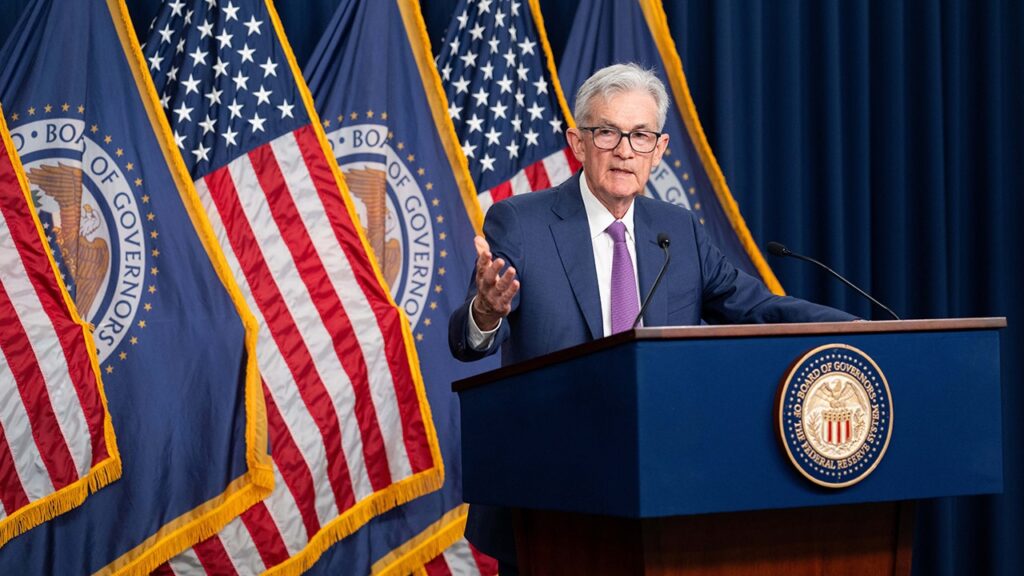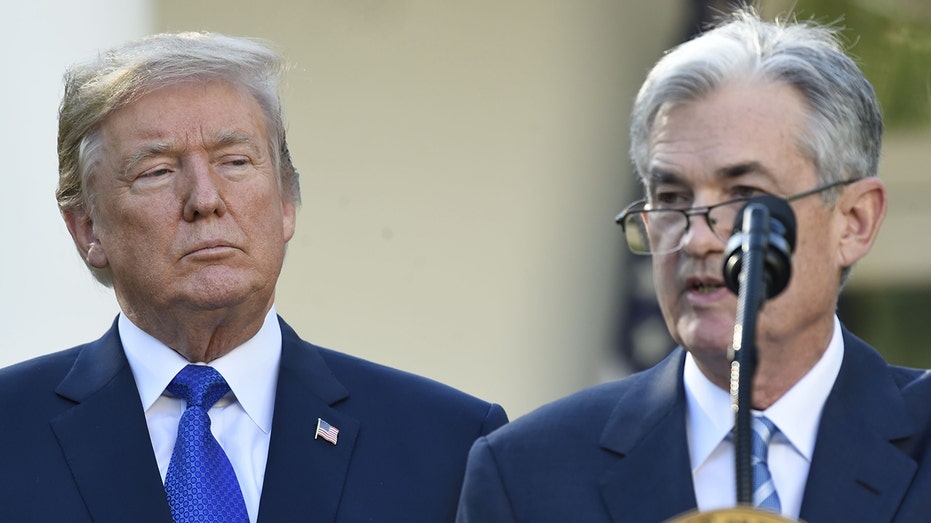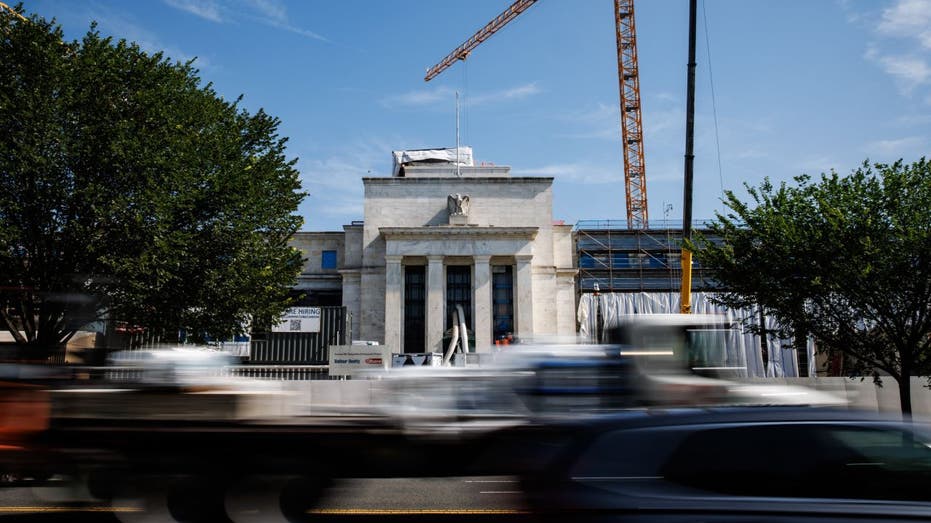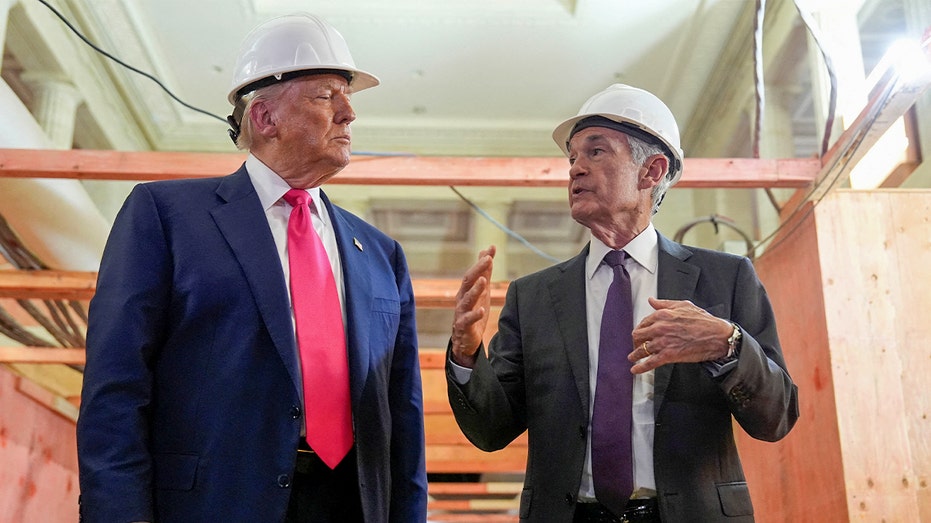
Federal Reserve leaves interest rates unchanged. FOX Business White House correspondent Edward Lawrence with more.
The Federal Reserve on Wednesday announced that it will leave its benchmark interest rate unchanged, as policymakers decided to hold rates steady amid elevated economic uncertainty as they continue to monitor inflationary pressures and labor market data.
The central bank’s decision leaves the benchmark federal funds rate at a range of 4.25% to 4.5%, where it has remained following all five of the Fed’s policy meetings this year. The central bank cut rates at its final three meetings in 2024, including a 50-basis-point cut in September and a pair of 25-basis-point reductions in November and December.
The Federal Open Market Committee (FOMC), which guides the central bank’s monetary policy moves, noted in its announcement that « recent indicators suggest that the growth of economic activity moderated in the first half of the year. The unemployment rate remains low, and labor market conditions remain solid. Inflation remains somewhat elevated. »
The FOMC voted 9-2 to leave rates unchanged, with Fed Governors Michelle Bowman and Christopher Waller dissenting from the decision on the grounds that they would have cut the federal funds rate by 25-basis-points. One governor was absent and didn’t vote at this meeting. It was the first time since 1993 that two FOMC members dissented from a rate decision.
FED MEETING LOOMS AS TRUMP CELEBRATES 3% GDP GROWTH, PUSHES FOR RATE CUTS

Federal Reserve Chair Jerome Powell said the economy is in a « solid position » despite uncertainty over trade policy, inflation and the labor market. (Photo by Liu Jie/Xinhua via Getty Images / Getty Images)
Federal Reserve Chair Jerome Powell spoke at a press conference following the decision and said the central bank is focused on its dual mandate goals of maximum employment and stable prices, noting that « despite elevated uncertainty, the economy is in a solid position. »
He noted that despite today’s report that second quarter GDP grew at an annual rate of 3%, that the economy’s growth in the first half of 2025 was closed to 1.2% when accounting for the 0.5% contraction in the first quarter.
Powell added that data suggests the labor market is « broadly in balance and consistent with maximum employment, » and while inflation has eased from its 2022 highs, it remains elevated relative to the Fed’s 2% longer-run goal.
« Changes to government policies continue to evolve, and their effects on the economy remain uncertain. Higher tariffs have begun to show through more clearly to prices of some goods, but their overall effects on economic activity and inflation remain to be seen, » Powell explained.
« A reasonable base case is that the effects on inflation could be short-lived, reflecting a one-time shift in the price level. But it is also possible that the inflationary effects could instead be more persistent, and that is a risk to be assessed and managed, » he added. « Our obligation is to keep longer-term inflation expectations well-anchored, and to prevent a one-time increase in the price level from becoming an ongoing inflation problem. »
ONE OF TRUMP’S TOP PICKS FOR FED CHAIR DOUBLES DOWN ON RATE CUT DEMANDS

President Trump nominated Powell as Fed chair in 2017, though he has repeatedly criticized in the years since. ( SAUL LOEB/AFP via Getty Images / Getty Images)
Powell was asked about whether the central bank is weighing rate cuts in September, as policymakers will have two more rounds of inflation and labor market data before their next meeting. He replied by noting the FOMC will take that data under consideration, though no decisions have been made about future interest rate moves and emphasized the Fed doesn’t do that in advance.
When asked if the Trump administration’s recently announced trade deals have added certainty, Powell acknowledged it’s been « a very dynamic time for trade negotiations » but that we’re « still a ways away from seeing where things settle down » because there are « many uncertainties left to resolve. »
The dissents by two Fed governors, Bowman and Waller, were the topic of a question posed to Powell, who said, « What you want from everybody, and also from a dissenter, is a clear explanation for what you’re thinking and what are the arguments you’re making, and that’s what we had today. »
WHAT ARE TARIFFS, HOW DO THEY WORK AND WHO PAYS FOR THEM?
Powell fielded a question about whether September provides policymakers with enough time to judge the effects of tariffs on inflation data, and whether the cost of those import taxes are being passed on to consumers.
« The evidence seems to be mostly not paid – paid only to a small extent – through exporters lowering their price, and companies or retailers, people and institutions who are upstream, paying most of this for now… it’s starting to show up in consumer prices, as you know in the June report. We expect to see more of that, » Powell said.
« We know from surveys that companies feel they have every intention of putting this through to the consumer. But the truth is, they may not be able to in many cases, so we’re just going to have to watch and learn empirically and learn how much of this and over what period of time, » he explained.

Construction on the Marriner S. Eccles Federal Reserve building in Washington, DC, US, on Thursday, July 17, 2025. (Samuel Corum/Bloomberg via Getty Images / Getty Images)
FOX Business Network’s Edward Lawrence asked about the impact of the Fed’s monetary policy on the housing market, which has slowed amid elevated mortgage rates and tight supply.
« Housing is a special case, » Powell replied. « We don’t set mortgage rates at the Fed, we set an overnight rate and the rates that go into mortgages are longer-term rates like Treasury rates – might be 30-year rates, might be shorter than that – but it’s not the overnight Fed’s rate. It’s not that we don’t have any effect, we do have an effect, but we’re not the main effect. »
« There are other things that’s going on in the housing sector, and one of those is just kind of a long-term housing shortage that we have. We haven’t built enough housing. This is not something that the Fed can help with and that will be the case even after things normalize, so I think that the best thing we can do for housing is to have 2% inflation and maximum employment, » he explained.
FEDERAL RESERVE INDEPENDENCE AT RISK FROM TRUMP’S PRESSURE CAMPAIGN, J.P. MORGAN WARNS
Powell was also asked about President Donald Trump’s efforts to pressure Powell and the Fed to cut interest rates and whether his criticisms run the risk of undermining the central bank’s independence going forward.
« I will just say that I think that having an independent central bank has been an institutional arrangement that has served the public well, and as long as it serves the public well, it should continue and be respected, » he explained. « If it didn’t serve the public well, then it shouldn’t be something that we should just automatically defend. »
« What it gives us and other central banks… is the ability to make these very challenging decisions in ways that are focused on the data and the evolving outlook, the balance of risks, all the things we talk about and not political factors, » he said.
« Governments all over the advanced economy world have chosen to put a little bit of distance between direct political control of those decisions and the decision-makers. If you were not to have that, it would be a great temptation of course to use interest rates to affect elections, for example, and that’s something that we don’t want to do, » Powell explained. « I think that’s pretty widely understood, certainly it is in Congress, and I mean I think it’s very important, I would say that. »

President Donald Trump became the fourth president to visit the Fed last week, when he met with Powell at the site of the central bank’s controversial headquarters renovation. (REUTERS/Kent Nishimura / Reuters)
TRUMP CALLS FED CHAIR POWELL A ‘KNUCKLEHEAD,’ SAYS INTEREST RATES SHOULD BE BELOW 1%
The FOMC will hold its next meeting on September 16 and 17, when rate cuts could occur – though the market’s view of the probability of a cut at that time has declined since Wednesday’s Fed decision.
« The rate-setting committee has set the stage to take action at the next meeting, » said LPL Financial chief economist Jeffrey Roach. « If economic conditions weaken, the committee will likely cut rates by a quarter point in September. »
« The two dissents were well-telegraphed but are certainly interesting in light of the continued robust economic data and strong earnings season, suggesting that at least two committee members may be willing to park their data dependency approach to the side, » said Seema Shah, chief global strategist at Principal Asset Management.
« Furthermore, the slightly dovish statement suggests that Waller’s concerns of underlying labor market weakness may be gaining more traction amongst the committee. It appears that the odds are slowly gathering in favor of a September cut, but ultimately the incoming jobs data and inflation prints likely still hold the key, » Shah added.
GET FOX BUSINESS ON THE GO BY CLICKING HERE
The market reacted to the FOMC announcement and Powell’s comments as indicating a September rate cut is less likely. The CME FedWatch tool showed the probability of rates staying at their current level rising from 35.4% a day ago to 51.8% after the announcement, with the likelihood of a 25-basis-point cut falling from 63.3% yesterday to 47.3% today.
